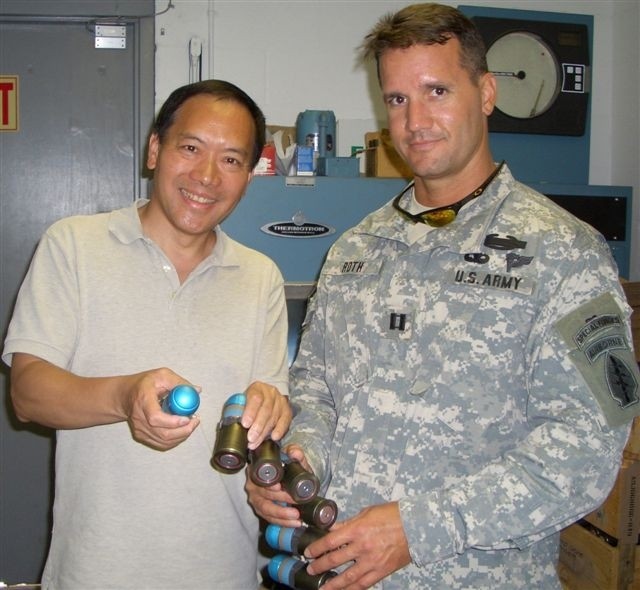PICATINNY ARSENAL, N.J. - The United States Patent and Trademark Office recently issued an Armament Research, Development and Engineering Center employee two patent approvals for new designs to be incorporated into the ammunition belt for the MK 19 grenade machine gun.
ARDEC is a subordinate element of the U.S. Army Research, Development and Engineering Command.
The Mk 19 40 mm grenade machine gun is used by all military services to deliver intense firepower against enemy personnel and lightly armored vehicles.
The designs to be incorporated into the belt, which is called a 40 mm M16A2 link, are meant to keep gunners safer on the battlefield, help conserve ammunition and save money.
ARDEC engineer Eric Goon designed the new concepts, the first of which is a coupling, or pivoting, used to connect grenade ammunition cartridge loops.
The new coupling design provides a potential life-saving feature. It allows MK 19 gunners to attach ammunition belts without having to reload the weapon when under hostile gunfire, Goon said.
In the current attachment system, grenade ammunition comes in a continuous link of 32 grenades, Goon said. The grenades cannot be detached, or reattached to other ammunition belts, unless they are cut or pried open.
Therefore, if a MK 19 gunner needs more ammunition he must open the feed cover to reload. With the new attachment, an assistant gunner could fasten another belt to the partial belt so that the weapon does not require reloading.
Goon said this saves time and potentially a Warfighter's life.
The reattachment feature also allows military members to recover partially used clips and attach them to other ammunition belts for future use, he said. This new reattachment feature provides a way of salvaging costly field ammunition that would be rendered useless or costly to recover with the current design.
Goon estimates the coupling will save the Army more than $2 million dollars per year in unused grenade rounds, which cost approximately $40 per round.
The second patent invention is for a new method of making 40 mm one-piece loops for the grenade ammunition cartridge.
The metal loop, which surrounds the individual grenade, is what the coupling will attach to in order to link the grenades together.
Currently the loop comes in two parts and is bonded together using resistance-welding, Goon said. This welding, although effective, is seen as an undesirable operation because the welded sections could potentially rust over time, weakening the bond and threatening the integrity of the link.
The approach taken for the invention is to eliminate the welds in their entirety, creating a solid one-piece loop, he said.
This new single-piece loop design offers a more durable product, a 15 percent weight reduction of the component and a potential cost reduction of approximately 30 percent, said Goon.
For the Soldier
Goon said he decided to improve the grenade ammunition link after a request from troops in the field who said they needed a reliable way to reuse ammunition through re-linking the belts.
He heard about the issue through an ARDEC engineer team deployed in battle zones to survey Warfighters and gain feedback about complaints or technological deficiencies.
"When I heard about that I said, 'Wait, we need to answer the call for the Soldier, our customer,'" Goon said. "I said 'let's do something about it.' "
Goon said he spent approximately six months designing the inventions.
Once incorporated, Goon said the new invention designs will not be noticeable to the military members who use the product, except for the enhanced pivoting features. There will be no modification in the way the user handles the weapon system.
"I didn't want to change the whole system, because it would be too costly," Goon said. Instead, he "enhanced" the current system to make it more efficient.
Troops could see the coupling device as early as fiscal year 2009 and the one-piece loop as early as fiscal year 2010.


Social Sharing